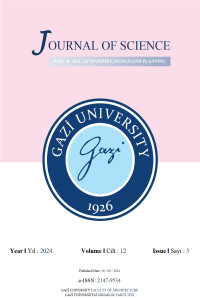Abstract
References
- [1] Connerton, P. (1999) Toplumlar Nasıl Anımsar? (Çev: A. Şenel) İstanbul: Ayrıntı Yayınları.
- [2] Assmann, J. (2001). Kültürel Bellek: Eski Yüksek Kültürlerde Yazı, Hatırlama ve Politik Kimlik. Çev. A. Tekin. İstanbul: Ayrıntı.
- [3] West C (2011) Memory-Recollection-Culture-Identity-Space: Social Context, Identity Formation, And Self-Construction Of The Calé (Gitanos) İn Spain, In Cultural Memories Springer, Dordrecht. 101-119.
- [4] Sturkin, M. 1997, Tangled Memories: the Vietnam war, the aids epidemic, and the politics of remembering, Berkeley: Univ. Calif. Pres. s.3
- [5] Halbwachs, M. (1992) On Collective Memory, University of Chicago.
- [6] Schudson, M. (2007) “Kolektif Bellekte Çarpıtma Dinamikleri”, Cogito. Bellek: Öncesiz, Sonrasız (50), s. 179-199.
- [7] Nora, P. (2006) Hafıza Mekânları. (Çev: M. E. Özcan), Ankara:Dost Kitabevi.
- [8] Çam, A. and Şanlıer, İ. (2019). Toros Yayla Köylerinde Sinema Deneyimleri: Modernlik, Şehir, Sinema ve Seyirci İlişkilerine Dair Bir Soruşturma. SineFilozofi, Özel Sayı, 415-436.
- [9] Thompson, P. (1999). Geçmişin Sesi: Sözlü Tarih. Çev. Ş. Layıkel. İstanbul: Tarih Vakfı Yurt Yay.
- [10] Traverso, E. (2009). Geçmişi kullanma kılavuzu tarih, bellek, politika (I. Ergüden, Çev.). Versus. (Orijinal basım tarihi 2005).
Abstract
Throughout the history, cinema and architecture have evolved in different ways by establishing a direct connection with the social, political or cultural structure of the period. The establishment of the Turkish Republic led to the construction of numerous buildings in urban and public spaces, aligning with the new form of government. Simultaneously, radical changes occurred in cultural and entertainment structures as another facet of westernization. Starting from the 19th century, the role attributed to movie theaters, upon entering Ottoman territory, underwent significant changes throughout that period. Cinema venues became a symbol of modernization. After Ankara was declared as the capital of the Turkish Republic, cinema venues, which had been concentrated in Istanbul before, began to gain more space in the city with the effect of the changing cultural/artistic environment, and in time, a city-specific cinema- going culture emerged in Ankara. From the 1920s to the present day, the importance of cinema venues in Ankara have increased for both the memory of the city and the memory of the audience of that period. Although there are numerous studies on cinema venues in architectural literature, it is challenging to find studies specifically addressing the impact of architectural structure on the audience's viewing experience. Since the oral history research is sampled with ordinary people, there is a chance for the exploration of unwritten historical events or specifying uncertain dates of those to be included in the literature. Cinema venues are not only places where screenings are held, but also places where the experiences are embodied in the memories of the audience. For this reason, this study will analyze data from oral history studies conducted by researchers in the field of cinema studies. It is aimed to examine the effects of the cinema environment of Ankara and the cinema buildings of the period on audience memory. Since the most noteworthy movie theater in the memory of the participants was the Büyük Sinema, this study aims to investigate how that building remains in the audience memory and how the architectural aspects affect audience experience.
References
- [1] Connerton, P. (1999) Toplumlar Nasıl Anımsar? (Çev: A. Şenel) İstanbul: Ayrıntı Yayınları.
- [2] Assmann, J. (2001). Kültürel Bellek: Eski Yüksek Kültürlerde Yazı, Hatırlama ve Politik Kimlik. Çev. A. Tekin. İstanbul: Ayrıntı.
- [3] West C (2011) Memory-Recollection-Culture-Identity-Space: Social Context, Identity Formation, And Self-Construction Of The Calé (Gitanos) İn Spain, In Cultural Memories Springer, Dordrecht. 101-119.
- [4] Sturkin, M. 1997, Tangled Memories: the Vietnam war, the aids epidemic, and the politics of remembering, Berkeley: Univ. Calif. Pres. s.3
- [5] Halbwachs, M. (1992) On Collective Memory, University of Chicago.
- [6] Schudson, M. (2007) “Kolektif Bellekte Çarpıtma Dinamikleri”, Cogito. Bellek: Öncesiz, Sonrasız (50), s. 179-199.
- [7] Nora, P. (2006) Hafıza Mekânları. (Çev: M. E. Özcan), Ankara:Dost Kitabevi.
- [8] Çam, A. and Şanlıer, İ. (2019). Toros Yayla Köylerinde Sinema Deneyimleri: Modernlik, Şehir, Sinema ve Seyirci İlişkilerine Dair Bir Soruşturma. SineFilozofi, Özel Sayı, 415-436.
- [9] Thompson, P. (1999). Geçmişin Sesi: Sözlü Tarih. Çev. Ş. Layıkel. İstanbul: Tarih Vakfı Yurt Yay.
- [10] Traverso, E. (2009). Geçmişi kullanma kılavuzu tarih, bellek, politika (I. Ergüden, Çev.). Versus. (Orijinal basım tarihi 2005).
Details
| Primary Language | English |
|---|---|
| Subjects | Interior Architecture , Architectural Design, Architecture (Other), Interaction and Experience Design |
| Journal Section | Architecture |
| Authors | |
| Publication Date | September 30, 2024 |
| Submission Date | March 31, 2024 |
| Acceptance Date | September 4, 2024 |
| Published in Issue | Year 2024 Volume: 12 Issue: 3 |


